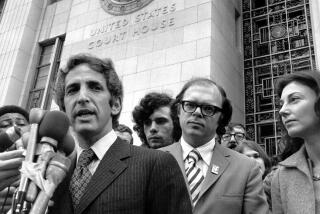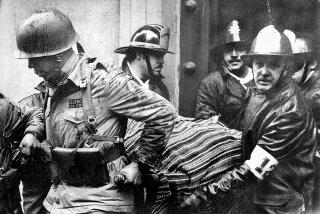CHENEY’S KEY ROLE IN LEAK CASE DETAILED
WASHINGTON — In the first such account from Vice President Dick Cheney’s inner circle, a former aide testified Thursday that Cheney personally directed the effort to discredit an administration critic by having calls made to reporters in 2003.
Cheney dictated detailed “talking points” for his chief of staff, I. Lewis “Scooter” Libby, and others on how they could impugn the critic’s credibility, said Catherine J. Martin, who was the vice president’s top press aide at the time.
Libby is on trial on charges of obstructing an investigation into how the name of a CIA operative, Valerie Plame, became public. The government says her identity emerged in conversations Libby had with several reporters. It is illegal to knowingly divulge the name of a CIA employee.
Plame’s name came up in the conversations because she is the wife of former envoy Joseph C. Wilson IV, the critic whom the administration was trying to attack after he publicly raised questions about the intelligence used to justify the invasion of Iraq.
Martin, who is now deputy White House director of communications for policy and planning, testified as a prosecution witness on the third day of Libby’s trial. She became the third witness to testify that they had told Libby of Plame’s identity well before Libby spoke with the reporters.
That contradicts Libby’s statement that he learned of Plame’s identity from one of the reporters, Tim Russert of NBC News. Libby is charged with lying to federal agents looking into the leak of Plame’s name.
The events unfolded after a New York Times columnist reported in May 2003 that an unnamed diplomat had been sent to Niger the previous year to investigate reports that Saddam Hussein had tried to buy uranium from Africa, and found that the reports were wrong. President Bush’s State of the Union speech in January 2003 contained the uranium assertion.
Libby learned that the unnamed diplomat was Wilson, a former ambassador.
Cheney’s active role in the campaign to undermine Wilson has been known, but Martin’s testimony was the first inside account of the administration’s attempts to manage the affair.
Martin said she learned that Plame worked for the CIA after Libby directed her to call the agency to get more information about Wilson’s trip to Niger. Martin said she quickly reported the information about Plame to Libby and Cheney.
She described details of a White House media strategy, designed at the highest levels, that sought to rebut charges that Bush had misled the public in his January 2003 speech.
Martin said Cheney’s talking points disputed Wilson’s allegation that Cheney had authorized the trip to Niger. They also included information from a secret National Intelligence Estimate.
The vice president ordered press aides to start tracking press coverage closely, while Libby was directed to contact reporters. At one point, the vice president gave a note card to Libby with information to give to a Time magazine reporter covering the case, while Cheney and Libby were returning on Air Force Two from the christening of an aircraft carrier.
Martin also described how she discussed with Libby media “options” to rebut Wilson that included a strategic “leak” to a handful of reporters.
But Martin said that neither Cheney nor Libby had suggested that the identity of Plame be divulged as part of the game plan. She said that she had no knowledge of either actually doing so.
“I recall the vice president telling me to keep track of this story, and keep track of the commentators who were continuing to write on this story and talk about us,” Martin testified. “We were paying attention to ‘Hardball With Chris Matthews’ because he had been talking about it a lot.”
She described the reaction inside the administration as questions began to be raised, starting in May 2003. The New York Times column said the administration had engaged in a “campaign of wholesale deceit” and suggested that Cheney was directly involved.
Martin said Libby asked her to call the then-chief public affairs officer at the CIA, William Harlow, to find out about the trip by Wilson.
“So I was saying, ‘Who sent him? Who is this guy?’ ” Martin testified. “I remember Bill Harlow saying his name was Joe Wilson, he was a charge in Baghdad, and his wife works over here.”
Martin said she promptly went to see Cheney and Libby with the news.
Wilson published an op-ed column in the New York Times on July 6, 2003, describing his trip. The same day, he aired his concerns on the NBC program “Meet the Press.” Almost immediately, Martin said she was huddling again with Cheney about how to respond to a surge in press inquires.
“He dictated to me what he wanted to say,” Martin said.
The detailed response covered eight points, including a reference to a sensitive intelligence-community assessment. Martin testified that she was “not sure if I could use that point” because she believed at the time that the report was classified.
Later, she said, she discussed with Cheney and Libby how she had learned from Harlow that two network reporters were writing stories about the case, and how Cheney ordered Libby to call them personally, including one call that Libby made from his private anteroom outside of Cheney’s office.
“I was aggravated that Scooter was calling the reporters and that I wasn’t,” Martin said.
The trial is expected to resume Monday with testimony from former White House Press Secretary Ari Fleischer.
*
(BEGIN TEXT OF INFOBOX)
Leak case timeline
I. Lewis “Scooter” Libby, former chief of staff to Vice President Dick Cheney, is being tried on five counts related to the leak of CIA operative Valerie Plame’s name in 2003. Some important events in the case:
2003:
* Jan. 28: President Bush says in his State of the Union address: “The British government has learned that Saddam Hussein recently sought significant quantities of uranium from Africa.”
* May 6: New York Times columnist Nicholas D. Kristof reports that a former ambassador, whom he does not name, had been sent to Niger in 2002 to investigate the uranium report. The column says the former envoy reported to the CIA and State Department well before Bush’s speech that the uranium story was unequivocally wrong and was based on forged documents.
* May 29: Libby asks Marc Grossman, an undersecretary of State, for information about the ambassador’s travel to Niger. Grossman later tells Libby that Joseph C. Wilson IV is the former ambassador.
* June 11 or 12: Grossman tells Libby that Wilson’s wife works at the CIA and that State Department personnel are saying Wilson’s wife was involved in planning the trip. A senior CIA officer gives him similar information.
* June 12: Cheney advises Libby that Wilson’s wife works at the CIA.
* June 14: Libby meets with a CIA briefer and discusses “Joe Wilson” and his wife, “Valerie Wilson.”
* June 23: Libby meets with New York Times reporter Judith Miller. He tells Miller that Wilson’s wife might work at a bureau of the CIA.
* July 6: The New York Times publishes an opinion piece by Wilson titled “What I Didn’t Find in Africa,” and he appears on NBC’s “Meet the Press.” Wilson said he doubted Iraq had obtained uranium from Niger recently and thought Cheney’s office was told of the results of his trip.
* July 7: Libby meets with then-White House Press Secretary Ari Fleischer. Libby notes that Wilson’s wife works at the CIA and that the information is not widely known.
* July 8: Libby meets with Miller again and tells her that he believes Wilson’s wife works for the CIA.
* July 12: Libby speaks to Time magazine’s Matthew Cooper and confirms to him that he has heard that Wilson’s wife was involved in sending Wilson on the trip. Libby also speaks to Miller and discusses Wilson’s wife and says that she works at the CIA.
* July 14: Syndicated columnist Robert Novak reports that Wilson’s wife is a CIA operative on weapons of mass destruction and that two senior administration officials, whom Novak does not name, said she suggested sending her husband to Niger to investigate the uranium story.
* Sept. 26: A criminal investigation is authorized to determine who leaked Plame’s identity to reporters. Disclosing the identity of CIA operatives is illegal.
* Oct. 14 and Nov. 26: Libby is interviewed by FBI agents.
* Dec. 30: U.S. Atty. Patrick J. Fitzgerald in Chicago is named to head the leak investigation.
2004:
* January: A grand jury begins investigating possible violations of federal criminal laws.
* March 5 and March 24: Libby testifies before the grand jury.
2005:
* Oct. 28: Libby is indicted on five counts: obstruction of justice and two counts each of false statement and perjury.
2006:
* Sept. 7: Former Deputy Secretary of State Richard L. Armitage admits he leaked Plame’s identity to Novak and to Bob Woodward of the Washington Post. Armitage says he did not realize Plame’s job was covert. Woodward taped his June 13, 2003, interview with Armitage.
Source: Associated Press
More to Read
Sign up for Essential California
The most important California stories and recommendations in your inbox every morning.
You may occasionally receive promotional content from the Los Angeles Times.










